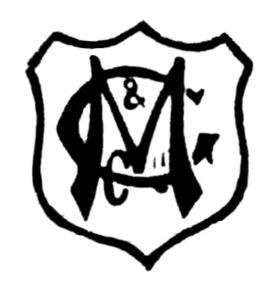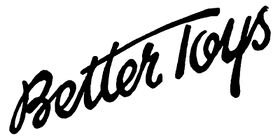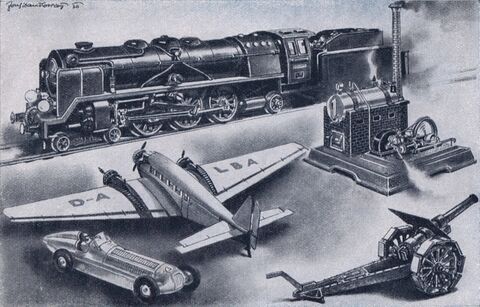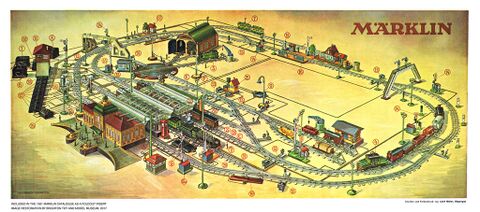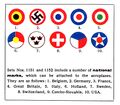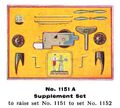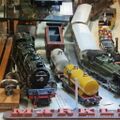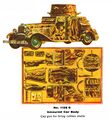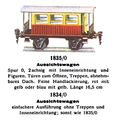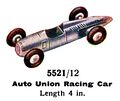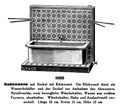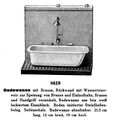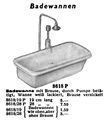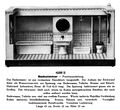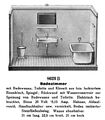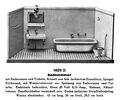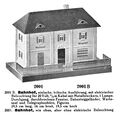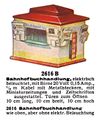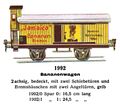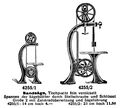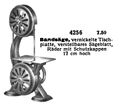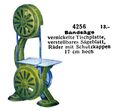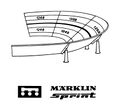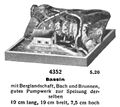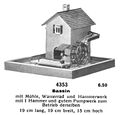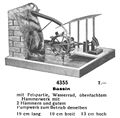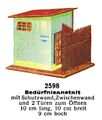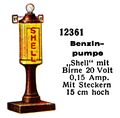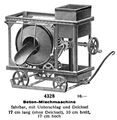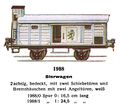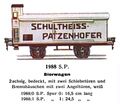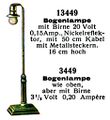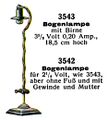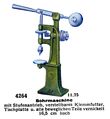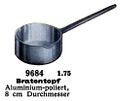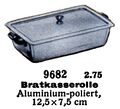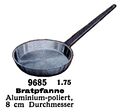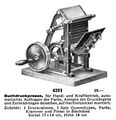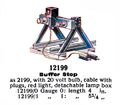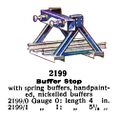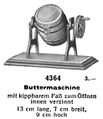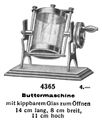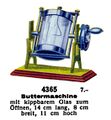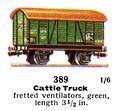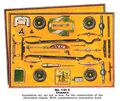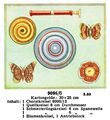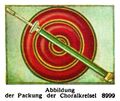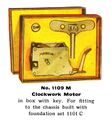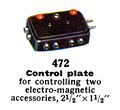Category:Märklin
| Toy Brands and Manufacturers |
|---|
Märklin |
| 1859 - |
1931: artwork showing the company's Gottingen factory [image info]
1932: artwork showing the company's Gottingen factory [image info]
1938 artwork showing the factory, and commemorating the company's winning of a Grand Prize (Grand Prix) in the 1937 Paris Expo ("Exposition Internationale des Arts et Techniques dans la Vie Moderne") [image info]
loco lettering [image info]
Märklin shield [image info]
Marklin catalogue front cover artwork [image info]
Marklin tinplate bridge, circa 1920 [image info]
The Marklin factory, image from the 1932 catalogue [image info]
1984: Special Jubilee Edition of Märklin Magazin [image info]
Interior view of Märklin's Leipzig Station 2037 [image info]
The Märklin ( or Maerklin ) toymaking business, started in 1859 in the toy and craftmaking region of Württemburg as W. Märklin by Theodor Märklin, is one of the great toymaker marques.
In 1888 the company became Gebrüder Märklin ("Märklin Brothers"), and the company absorbed the toymaker Lutz in 1891.
Märklin's toys are often recognisable through their solid build quality, the common use of stylised proportions in the earlier toys, and a certain stylistic imaginative exhuberance, coupled with engineering excellence.
Later creations put more emphasis on literal precision and correct proportions, but the more distinctively toylike products produced between ~1895 and ~1939 are sometimes referred to as belonging to the "Golden Age" of Märklin.
Company history
1859: Foundation
Tinsmith Theodor Friedrich Wilhelm Märklin (1817 - 1866) opened his metalworking workshop in Göppingen in 1859, the same year that he married Caroline. Caroline had a sharp business mind, and became the travelling sales representative for the business, with Theodor working in the workshp while Caroline obtained new sales orders and built up the business, their main "niche" business being the manufacture of toy dollhouse kitchen equipment, an area in which Theodor's metalworkign skills and Caroline's sales expertise overlapped.
After Theodor died in 1866, Caroline remarried in 1868 and managed to keep the business going, although of Theodor's two sons, Eugen Märklin (1861 - 1947) and Charles Märklin initially seemed to show no interest in joining the company.
1888: Gebr. Märklin
After Caroline's second husband died, Eugen started work at the company part-time, and in 1888 took over and restructured the business with the help of Karl, creating Gebr. Märklin (Märklin Brothers).
The new business no longer just made toy kitchens and stoves, but expanded to produce just about every small type of metal toys or associated item that one could think of, helped by the 1891 takeover of Lutz.
1891: Lutz
Ludwig Lutz (1820-1899) had founded a successful company making handcrafted painted tin toys, including clockwork cars and toy trains, and although Lutz had groomed his two sons and daughter to take part in and run the business, the company now needed an overhaul and investment in new machinery, and selling out to the new Gebr Märklin company seemed opportune. Märklin offered jobs to the existing Lutz workforce if they were prepared to move to Goppingen, acquiring a specialist workforce of toymaker-craftsmen, with a wide range of specialist skills. The resulting "rebooted" Gebruder Märklin could combine the Lutz workforce's creativity and finishing skills with more modern and efficient production techniques – toys could be made using machinery where possible, with the human element used where it had most effect, in the detailing.
The same year that they took over Lutz (1891), Märklin exhibited a model railway at the Leipzig Spring Fair consisting of a locomotive running on a figure-eight track with standardised parts that could be taken apart and reassembled in other ways, and the Märklin's following "Golden Age" is generally credited to have been a result of the cross-fertilisation of the two companies' combined best features.
1890s: Expansion
By the early 1890s, the expanded Gebr. Märklin et Cie was being run by Eugen Märklin with a new partner, Emil Friz, and the company moved to a larger site, at Marktgasse 21, in 1895.
1900: Further expansion
By the turn of the century, the new model railway range had become increasingly offered not just as a stand-alone system but as an expandable, collectable range, that ... as with dollhouses ... could be continually added to by the owner. Instead of being a toy that was just sold once, a model railway was never finished!
The possibilities of the Marktgasse premises were soon outstripped as the business kept growing, and the company raised additional investment and acquired Richard Safft as an additional partner, with the new money acquiring a larger premises at Stuttgarte Strasse,
1911: The famous factory
Emil Fritz' ambition of creating the largest and most advanced toy factory in the world seemed to be realised in 1911 when the company redeveloped the Stuttgarte Strasse site and replaced the existing building with an imposing six-storey edifice. The new building appeared proudly on the backs of a number of Märklin catalogues, and even appeared as a commemorative constructional model, Märklin 72150.
The Marklin factory is still is use today, supplemented by the Goppingen Marklin-Museum at another location.
1930s: 00-gauge
After continued expansion through the 1920s, the Märklin range was becoming bewilderingly vast, leading to the phasing out of support for gauge 2 and gauge 3. A few years after the necessary introduction of yet another gauge in 1935 (to counter the new sets made by Stefan Bing's new Trix company, the half-size 00/H0 and its further range of accessories also displaced gauge 1 from the catalogues, and the non-railway ranges started to contract with the restriction on the availability of raw materials. The catalogues didn't seem to be any smaller, but there was no longer much doubt that the company's focus was on model railways.
Post-war
Marklin, in common with other metal toymakers around the world, took some time to recover from the Second World War, but Germany's economy and materials supply was obviously even harder hit than those in Allied countries. Ironically, this may have helped Märklin's long-term survival – the enforced post-war contraction of the business and tight focus on a more restricted and manageable product range aimed at the domestic market made the company more able to cope when the arrival of cheap plastic mass-production caused a crisis for the toy industry in the 1950s and 1960s. Other long-established mega-firms such as Meccano Ltd. and Lines Brothers ("Tri-ang") in the UK, who had hoped for an eventual post-war return to their earlier levels of business, and hadn't restructured, didn't survive.
Märklin and gauge
Although Märklin went on in the 1890s to produce everything from enamelled toy fountains to scientific equipment, their main achievement during this decade is usually taken to be the introduction of the concept of standardised gauges for model railways. Where model trains had tended to be single items that were often floorbound (because the investment in making track to go with each model didn't seem worthwhile), Märklin recognised that if one was to build railway sets, it wasn't sensible to make new sets of track to go with each arbitrary-sized model train ... track had to be standardised, with subsequent trains designed to fit the existing track, rather than the track being designed to fit the trains.
The size of track in the sets introduced by Märklin in 1891 became Gauge I (Spur I), and was joined by a range of larger and progressively larger-numbered track gauges, gauge II and gauge III, followed in about 1900 by a smaller gauge, gauge 0. These standard gauges promoted interoperability between different companies' products, and reduced the risk both for buyers purchasing a model railway and for third-party companies supplying specialised accessories and components. For a small company whose expertise was track, or locomotives, or rolling stock, standardised gauges meant that they could sell into existing markets without having to invest in manufacturing entire model railway sets themselves, or having to depend on the business strategy of any one external company. The standardised gauging system created an ecology of companies around each gauge, reassuring buyers that their investment wasn't dependent on a single company or product line, and reassuring smaller companies that these were stable markets to sell into.
Märklin discontinued Gauge 2 in 1920, and the even larger gauge 3 in around ~1922, with subsequent 1920s catalogues typically only showing either the gauge 0 or gauge 1 version of a product, but proclaiming that practically every product was available in both sizes.
After the launch of Märklin's 00/H0 range in 1935, given pride of place at the very front of the 1935 catalogue, the writing was on the wall for the large gauge 1 product lineup, which didn't reappear in the 1938 catalogue and didn't seem to reappear until around ~1969.
Marklin's 1:220 Z gauge system appeared in 1972.
1925 promotional text:
What's in a name?
EVERYTHING! because everything in the world has a name – the best model railways that are made naturally have one, and are known as MARKLIN models. Wherever you see the name MARKLIN and the picture of the "Laughing Boy's Head," there you will be sure of getting the very finest quality models obtainable. Each is a facsimile of the real thing and has been carefully built to scale, and painted in correct colours, to create – not merely a strong, durable and efficient toy, but one that will be of scientific and educational interest to every one of us.
Great care and attention has been devoted to every detail in their construction, and each working part is conscientiously examined, and tested, before it is allowed to leave the Works – ( as in the manufacture of its counterpart in real life).
The lucky boy who possesses a Marklin Locomotive or Model Railway has a toy that will interest and instruct him for years.
— , W.Seelig / Märklin, , The Märklin Clockwork Railway Handbook, , ~1925
Addresses
The company museum will probably be the first point to contact for enquiries from the general public (other than the website).
- Märklin Museum
- Märklin-Museum Reutlinger Str. 2, 73037 Göppingen, Germany
- Factory
- Gebr. Märklin & Cie. GmbH. Stuttgarter Str. 55, 73033 Göppingen, Germany
Märklin image library
The Brighton Toy and Model Index currently has over eleven hundred individual edited Märklin images, mostly from catalogues from 1906-1939.
In the museum
Not all of the museum's public Märklin exhibits are yet listed on the Index, but we estimate that there are probably around 90-100 items arranged around the museum, comprising the most comprehensive permanent public collection in the UK, and one of the best in Europe and the World. There's a dedicated Märklin cabinet in Arch Three, locos, buildings and accessories in the Bassett-Lowke cabinet and on the central 1930s layout, a Marklin construction set and model in the metal construction sets cabinet, and a Märklin cooker and accessories in the Toy Kitchen cabinet.
See also:
References and links
- Märklin homepage (maerklin.com)
- MarklinStop.com - All about Marklin, 1859 - present (marklinstop.com)
- Märklin stationary steam engines (johno.myiglou.com)
- Märklin (wikipedia.org)
- Märklin resources page (macbeth66.com)
- Gilles Herve, Charlotte Parry-Crooke, Märklin 1895-1914 (Ingram, 1983) ISBN 0907724035
clubs and groups:
- Märklin Model Railway Club, New Zealand (mmrc.org.nz)
- Märklin Model Railway Club of South Australia, MMRCSA (mmrcsa.com.au)
- Märklinfan Club Italia (marklinfan.net)
- Märklin Users Forum (marklin-users.net)
the Märklin museum:
Subcategories
This category has the following 42 subcategories, out of 42 total.
0
- Märklin 00-gauge (23 P, 58 F)
1
- Märklin gauge 1 (11 P, 234 F)
A
- Aeroplane Construction Sets (Märklin) (1 P, 9 F)
- Märklin Army Vehicles (32 F)
B
- Märklin for Bassett-Lowke (3 P, 6 F)
- Märklin Bathroom (11 F)
C
- Märklin catalogues (25 F)
G
- Märklin goods train rolling stock (25 P, 263 F)
- Märklin guns and artillery (1 P, 40 F)
H
- Hamo (empty)
J
- Josef Danilowatz (1877-1945) (6 F)
K
- Märklin Kitchen (1 P, 28 F)
L
- Märklin lamps and lights (6 P, 22 F)
M
- Marklin roadway (6 F)
- Marklin Sprint accessories (2 F)
- Marklin Sprint cars (16 F)
- Marklin Sprint sets (6 F)
- Marklin Sprint track (9 F)
- Minex construction sets (13 F)
- Märklin bridges (3 P, 18 F)
- Märklin miscellaneous (2 P, 12 F)
- Märklin Model Railways (display) (35 P, 31 F)
P
- Märklin passenger train rolling stock (16 P, 107 F)
R
S
- Märklin Spinners (50 F)
- Märklin Stations (3 P, 19 F)
- Märklin Steam (31 F)
V
- Märklin miniature vehicles (55 F)
W
- Märklin Working Models (66 F)
Pages in category ‘Märklin’
The following 108 pages are in this category, out of 108 total.
B
C
- Car No4 Pullman Carriage (Marklin gauge 1)
- Charles Dickens locomotive LNWR 955, 110V electric, gauge 1 (Märklin D-3021-Ch-D)
- Circus Lion in Cage (Märklin)
- CIWL coaches (Marklin)
- CIWL Sleeping Car (Märklin 346-3J)
- Cleopatra Pullman car (Marklin gauge 1)
- Cleopatra Pullman car (Marklin ~2890-0)
- Closed Goods Truck (Märklin 1997-0)
- Cock O’ The North locomotive LNER 2001 (Märklin L70-12920LNER)
- Container Wagon (Marklin 28581)
- Cooking range (Marklin)
- Covered Goods Wagon (Marklin 353 365+)
- Covered Junction Platform, arched, gauge 0 (Märklin 2078)
- Crane Truck, 10 Ton (Marklin 366)
D
- Der Adler 1835-1935 Centenary train set (Märklin AR12930-35-3)
- Deutsche Reichsbahn DR postal service carriage, H0 (Marklin 346-5)
- Double 'Fish-belly' Railway Bridge - Doppelfischbauchbrücke (Märklin 2503)
- DRG Berlin-Munchen passenger coach 19410, with interior fittings (Märklin 1941-G)
- DRG luggage coach (Marklin gauge 0)
E
F
G
- Garden Tea Party with table and four figures (Märklin 2678)
- Garden Tractor (Märklin Metallbaukästen)
- Goods Wagon, circa ~1902 (Märklin 1804)
- Gotthard Be 4/6 electric locomotive (Märklin S64-13020)
- Gotthard Be 4/6 electric locomotive, gauge 1 (Marklin HS-65-13021)
- Graf Zeppelin D-LZ130 airship (Marklin 11400 special edition)
- Guard's Van 605, circa 1902 (Märklin)
H
L
- LBSCR locomotive 22 (Marklin gauge 0)
- Lego-compatible railway truck, Bausteinwagen (Marklin 44734)
- Lego-compatible railway truck, LGB, Bausteinwagen (Marklin 94063)
- Leipzig Station - Kleiner Leipziger (Märklin 2037)
- Level Crossing, 00-gauge (Märklin)
- Level crossing, gauge 1, Gamages (Märklin 2822)
- Locomotive 89005 (Marklin 3000)
- Locomotive, green, 4-6-2 (Märklin HR 66-12920)
- Low-Level Bridge (Marklin 2065-1)
- Low-sided Open Goods Truck (Marklin 364)
- Luggage Van (Marklin 310)
- Luggage Van, DR (Marklin 344)
M
- Marklin Plus
- Meccano Clockwork Motor No2, black, 1912 (Märklin for Meccano Ltd)
- Meccano Clockwork Motor No2, silver, 1912 (Märklin for Meccano Ltd)
- Mercedes-Benz SSK constructor clockwork racing car (Marklin 1103)
- Merchant Taylors Schools-Class loco SR 910 (Märklin for Bassett-Lowke)
- Milk Transport Wagon, gauge 0 (Märklin 1777-0)
- Mitropa Dining Car - Speisewagen (Marklin 352)
- Mitropa Sleeping Car - Schlafwagen (Marklin 353)
- Märklin Metallbaukasten metal construction set No 1 (Märklin)
P
- Paris-Orleans steeple cab loco PO E1 (Marklin CL3021B)
- Passenger Wagon 2nd Class - Personenwagen, Goppingen (Marklin 4040)
- Petroleum Comp Tanker Wagon, circa ~1902 (Märklin 1812)
- Platform Bookstall Trolley, with newspapers (Märklin 2628)
- Platform Buffet Trolley, with food (Märklin 2627)
- Poultry Wagon - Kleintierwagen (Marklin 386)
R
S
- Shell Petrol Tanker Wagon, gauge 0 (Märklin 1854 S)
- Station electric lamp, repaint, green (Märklin 3448)
- Station Electric Lamps (Märklin 3448)
- Station Master, with hut and electric arm (Märklin 1St 469)
- Station with Signal Bell (Märklin 2650)
- Stephenson Tank Locomotive SR 329, gauge 0 (Märklin TK1020)
- Stephenson Tank Locomotive SR 329, gauge 1 (Märklin TK1021)
- Street Lamp (Märklin 3449)
- Street Lamp (Märklin 3550)
- Street Lamps with Ladders (Märklin 2838)
- Swiss 2B1 electric locomotive (Marklin CS66-12920)
- Swiss 2B1 electric locomotive (Marklin CS66-12921)
- Swiss 2C1 electric locomotive (Märklin HS66-12920)
T
- Talbot Gravel Wagon with side-chute (Märklin 1767)
- Talbot Hopper Wagon - Schotter-wagen (Marklin 367)
- Tank Locomotive TM800 (Marklin TM800)
- Tanker Wagon, BP, H0 (Marklin 314)
- Tanker Wagon, Shell (Marklin 314)
- Tanker Wagon, Standard, ESSO (Marklin 374)
- Timber Truck (Märklin 372)
- Train Indicator (Märklin 2644)
- Train Indicator 2 (Märklin 2644)
- Tunnel (Märklin)
- Two-Button Controller (Märklin 472)
Media in category ‘Märklin’
The following 200 files are in this category, out of 1,228 total.
(previous page) (next page)- 00-gauge layout, night, Märklin, Leipziger Messe 1939 (MarklinCat 1939).jpg 3,200 × 2,176; 5.72 MB
- Abfährtstander - Departures Board, Märklin 2649 (MarklinCat 1931).jpg 1,389 × 1,053; 524 KB
- Acid Truck, Märklin 1990 (MarklinCat 1936).jpg 1,566 × 1,078; 403 KB
- Aeroplane Construction Set, Märklin 1151 (MarklinCat 1936).jpg 2,107 × 2,839; 3.33 MB
- Aeroplane Construction Set, Märklin 1152 (MarklinCat 1936).jpg 2,405 × 2,907; 3.98 MB
- Aeroplane Construction Sets, markings (MarklinCat 1936).jpg 1,781 × 1,553; 818 KB
- Aeroplane Construction Sets, Märklin (MarklinCat 1936).jpg 1,475 × 2,000; 1.72 MB
- Aeroplane Construction Supplement Set 1151A (MarklinCat 1936).jpg 1,219 × 1,096; 757 KB
- Alfa Romeo Racing Car, Märklin 5521-14 (MarklinCat 1936).jpg 930 × 718; 241 KB
- Alfa-Romeo-Rennwagen - Racing Car, Märklin 5521-14 (MarklinCat 1939).jpg 948 × 604; 222 KB
- Area 30c.jpg 1,024 × 768; 477 KB
- Area 32.jpg 1,024 × 1,021; 524 KB
- Armoured Car Body, for Car Construction Set, Märklin 1108G (MarklinCat 1936).jpg 2,112 × 2,329; 2.29 MB
- Aussichtswagen - Panoramic View Carriage, Märklin M1824 (MarklinSFE 1900s).jpg 1,167 × 841; 530 KB
- Aussichtswagen - Viewing Car, Märklin 1834 1835 (MarklinCat 1931).jpg 1,468 × 1,502; 771 KB
- Auto Union Racing Car, Märklin 5521-12 (MarklinCat 1936).jpg 919 × 774; 230 KB
- Auto Union Racing Car, Märklin 5521-2 (MarklinCat 1936).jpg 974 × 761; 260 KB
- Auto-Union-Rennwagen - Racing Car, Märklin 5521-12 (MarklinCat 1939).jpg 909 × 622; 213 KB
- Auto-Union-Rennwagen - Racing Car, Märklin 5521-16 (MarklinCat 1939).jpg 1,160 × 844; 359 KB
- Auto-Union-Rennwagen - Racing Car, Märklin 5521-2 (MarklinCat 1939).jpg 982 × 691; 233 KB
- Auto-Union-Rennwagen - Racing Car, Märklin 5521-62 (MarklinCat 1939).jpg 1,064 × 687; 281 KB
- Automatic Dial Balance Scales, Märklin 2605 (MarklinCat 1936).jpg 1,207 × 858; 389 KB
- Automatic Ticket Machine, Märklin 2651 (MarklinCat 1936).jpg 886 × 712; 275 KB
- Automatische Schnellwage - Automatic Scales, Märklin 2605 (MarklinCat 1931).jpg 987 × 1,377; 441 KB
- Automobil - Limousine Car, clockwork, Märklin 5209 (MarklinCat 1931).jpg 2,751 × 1,866; 1.74 MB
- Badewanne - Bath, Märklin 8600 (MarklinCatx 1931).jpg 1,816 × 1,620; 1.04 MB
- Badewanne - Bath, Märklin 8618 (MarklinCatx 1931).jpg 943 × 761; 214 KB
- Badewanne - Bath, Märklin 8619 (MarklinCatx 1931).jpg 1,507 × 1,598; 814 KB
- Badewannen - Bath, Märklin 8618 (MarklinCat 1939).jpg 1,478 × 1,642; 470 KB
- Badezimmer - Bathroom, Märklin 8598-B (MarklinCatx 1931).jpg 1,601 × 2,043; 1.3 MB
- Badezimmer - Bathroom, Märklin 8599-B (MarklinCatx 1931).jpg 2,401 × 2,207; 2.11 MB
- Badezimmer - Bathroom, Märklin 8623-B (MarklinCatx 1931).jpg 1,535 × 1,754; 1.08 MB
- Badezimmer - Bathroom, Märklin 8624-B (MarklinCatx 1931).jpg 1,961 × 1,638; 1.29 MB
- Baggage Car - Gepackwägen, DR, Märklin 354 354B 354J 354JB (MarklinCat 1939).jpg 2,129 × 1,249; 874 KB
- Baggage Trolley, Märklin 2693 (MarklinCat 1936).jpg 690 × 956; 166 KB
- Baggermaschine - Bucket Excavator, Märklin 4318 4316 (MarklinCat 1932).jpg 1,254 × 1,857; 535 KB
- Baggermaschine - Bucket Excavator, Märklin 4319 4317 (MarklinCat 1932).jpg 1,403 × 1,991; 716 KB
- Baggerwerke - Excavator, Märklin 4316 (MarklinCat 1939).jpg 1,136 × 1,435; 468 KB
- Bahnhof - Station, Märklin 2001 (MarklinCat 1931).jpg 1,874 × 1,792; 1.03 MB
- Bahnhof - Station, Märklin 2001-F (MarklinCat 1931).jpg 2,154 × 1,623; 1.02 MB
- Bahnhof - Station, Märklin 2003 (MarklinCat 1931).jpg 3,000 × 1,185; 1.21 MB
- Bahnhof - Station, Märklin 2029 (MarklinCat 1931).jpg 2,162 × 1,778; 1.25 MB
- Bahnhof - Station, Märklin 2030 (MarklinCat 1931).jpg 2,200 × 1,666; 1.05 MB
- Bahnhof - Station, Märklin 2033 (MarklinCat 1931).jpg 3,000 × 1,479; 1.18 MB
- Bahnhofbuchhandlung - Station Newsagent, Märklin 2616 (MarklinCat 1931).jpg 1,200 × 1,445; 812 KB
- Bahnhofhalle - Leipzig Station Canopy, Märklin 2078 (MarklinCat 1931).jpg 3,000 × 1,414; 1.48 MB
- Bahnsteigbüfett - Railway Station Buffet, Märklin 2617 (MarklinCat 1931).jpg 1,098 × 1,465; 742 KB
- Bahnsteigsperre - Railway Station Barrier, Märklin 2632 (MarklinCat 1931).jpg 1,007 × 1,397; 477 KB
- Bahnsteigsperre - Railway Station Barrier, Märklin 2633 (MarklinCat 1931).jpg 1,696 × 1,359; 709 KB
- Balancier-Dampfmaschine, model, Märklin Minex (MarklinCat 1939).jpg 2,074 × 1,391; 977 KB
- Bananenwagen - Banana Wagon, Fyffes, Märklin 1682 (MarklinCat 1939).jpg 1,170 × 965; 633 KB
- Bananenwagen - Banana Wagon, Fyffes, Märklin 1792 (MarklinCat 1931).jpg 1,799 × 1,358; 1.1 MB
- Bananenwagen - Banana Wagon, Fyffes, Märklin 1792 (MarklinCat 1939).jpg 1,578 × 1,041; 707 KB
- Bananenwagen - Banana Wagon, Märklin 1992 (MarklinCat 1931).jpg 1,532 × 1,327; 821 KB
- Band Saw, model, Märklin Metallbaukasten 4F (MarklinCat 1936).jpg 924 × 1,182; 391 KB
- Bandsäge - Band Saw, Märklin 4255-1 4255-2 (MarklinCat 1932).jpg 1,830 × 1,644; 658 KB
- Bandsäge - Band Saw, Märklin 4256 (MarklinCat 1932).jpg 1,412 × 1,234; 313 KB
- Bandsäge - Band Saw, Märklin 4256 (MarklinCat 1939).jpg 1,341 × 1,243; 413 KB
- Banked Curve Supports, Marklin Sprint 1546 (Marklin 1971).jpg 1,548 × 1,153; 607 KB
- Banked Curves 45-degrees, Marklin Sprint 1248 1268 (Marklin 1971).jpg 1,543 × 1,234; 592 KB
- Banked Curves, Marklin Sprint (Marklin 1971).jpg 1,631 × 1,457; 268 KB
- Barrier, Märklin 2219 2219-B (MarklinCat 1936).jpg 1,395 × 995; 179 KB
- Barrier, remote controlled, Märklin 13731 (MarklinCat 1936).jpg 1,837 × 896; 500 KB
- Barrière avec poteau Attention, Märklin 2219 (MärklinCatFr ~1921).jpg 1,927 × 1,061; 583 KB
- Bass Closed Goods Waggon, Märklin E1988-0 (MarklinCRH ~1925).jpg 1,433 × 1,066; 507 KB
- Bassett-Lowke, King George V 6000, gauge 0 (BL-MR 1937-11).jpg 1,541 × 2,130; 510 KB
- Bassett-Lowke, Merchant Taylors 910, gauge 0 (BL-MR 1937-11).jpg 1,526 × 2,226; 610 KB
- Bassin - Mountain Stream, Märklin 4352 (MarklinCat 1932).jpg 1,437 × 1,284; 570 KB
- Bassin - Water Mill, Märklin 4353 (MarklinCat 1932).jpg 1,529 × 1,461; 554 KB
- Bassin - Water Wheel, Märklin 4355 (MarklinCat 1932).jpg 1,553 × 1,525; 661 KB
- Bedeckter Güterwagen - Closed Goods Van, Märklin 1791 (MarklinCat 1939).jpg 1,562 × 1,021; 692 KB
- Bedeckter Güterwagen - Closed Goods Wagon, Märklin 1781 (MarklinCat 1939).jpg 1,418 × 1,069; 686 KB
- Bedeckter Güterwagen - Closed Goods Wagon, Märklin 1856 (MarklinCat 1939).jpg 1,857 × 1,074; 768 KB
- Bedeckter Güterwagen - Goods Van, Märklin 1781 (MarklinCat 1931).jpg 1,686 × 1,359; 1 MB
- Bedeckter Güterwagen - Goods Van, Märklin 1791 (MarklinCat 1931).jpg 1,788 × 1,427; 1.1 MB
- Bedeckter Güterwagen - Goods Van, with lights, Märklin 1791-B-0 (MarklinCat 1931).jpg 1,794 × 1,357; 1.09 MB
- Bedürfnisanstalt - Public Toilet, Märklin 2601 (MarklinCat 1931).jpg 1,075 × 1,380; 679 KB
- Bedürfnisanstalt - Public Toilets with screen, Märklin 2598 (MarklinCat 1931).jpg 1,026 × 1,204; 525 KB
- Bedürfnisanstalt - Public Urinals, Märklin 2596 (MarklinCat 1931).jpg 1,332 × 747; 318 KB
- Benzinpumpe - Petrol Pump, Shell, Märklin 12361 (MarklinCat 1931).jpg 876 × 859; 204 KB
- Beton-Mischmaschine - Concrete Mixer, Märklin 4328 (MarklinCat 1932).jpg 1,621 × 1,662; 769 KB
- Better Toys, Märklin (1930).jpg 1,600 × 800; 138 KB
- Bierwagen - Beer Wagon, Lowenbrau, Märklin 1968-N (MarklinCat 1931).jpg 1,255 × 992; 533 KB
- Bierwagen - Beer Wagon, Märklin 1988 (MarklinCat 1931).jpg 1,558 × 1,382; 834 KB
- Bierwagen - Beer Wagon, Schultheiss-Patzenhofer, Märklin 1988-SP (MarklinCat 1931).jpg 1,558 × 1,345; 798 KB
- Blauer Vogel - Bluebird Speed Record Car, Märklin 5521-18 (MarklinCat 1939).jpg 1,174 × 667; 319 KB
- Bluebird Record-Breaking Car, Märklin 5521-18 (MarklinCat 1936).jpg 1,185 × 822; 321 KB
- Bogenlampe - Street Lamp with four bulbs, Märklin 13453-4 (MarklinCat 1931).jpg 1,025 × 1,567; 341 KB
- Bogenlampe - Street Lamp with two bulbs, Märklin 13453-2 (MarklinCat 1931).jpg 1,027 × 1,481; 294 KB
- Bogenlampe - Street Lamp, Märklin 3499 (MarklinCat 1931).jpg 936 × 1,021; 282 KB
- Bogenlampe - Street Lamp, Märklin 3542 (MarklinCat 1931).jpg 933 × 1,035; 257 KB
- Bogenlampe - Street Lamp, Märklin 3550 (MarklinCat 1931).jpg 964 × 1,393; 320 KB
- Bogenlampe - Street Lamp, Märklin 3551 (MarklinCat 1931).jpg 1,137 × 1,493; 398 KB
- Bogenlampe - Street Lamp, Märklin 3553 (MarklinCat 1931).jpg 1,004 × 1,533; 386 KB
- Bohrmaschine - Drill Station, Märklin 4264 (MarklinCat 1939).jpg 1,393 × 1,513; 423 KB
- Bohrmaschine - Drill, Märklin 4263 (MarklinCat 1932).jpg 1,977 × 1,423; 483 KB
- Bohrmaschine - Drill, Märklin 4264 (MarklinCat 1932).jpg 1,584 × 1,279; 328 KB
- Bonds, Märklin sale (MM 1935-06).jpg 743 × 1,251; 171 KB
- Bottle Elevator, model, Märklin Metallbaukasten 101-1 (MarklinCat 1936).jpg 956 × 1,721; 775 KB
- Boys with Flying Boat, promotional artwork, Märklin Metallbaukasten (MarklinCat 1936).jpg 2,358 × 1,345; 1.71 MB
- Bracket Signal, Märklin 2819-0 (MarklinCRH ~1925).jpg 859 × 1,092; 196 KB
- Bracket, black (Märklin Metall).jpg 844 × 501; 133 KB
- Brake Van, LMS LNER, Märklin 2885-0 (MarklinCRH ~1925).jpg 1,340 × 1,065; 479 KB
- Brake Van, Märklin 1790 (MarklinCat 1936).jpg 1,505 × 1,119; 744 KB
- Braunkohlenstaubwagen - Brown Coal Dust Wagon, Märklin 1775 (MarklinCat 1939).jpg 1,538 × 1,092; 737 KB
- Bretterwagen - Timber Wagon, Märklin 1966 (MarklinCat 1931).jpg 1,453 × 954; 592 KB
- Bretterwagen - Timber Wagon, Märklin 1966 (MarklinCat 1939).jpg 1,353 × 928; 590 KB
- Bridge, 00, Märklin 462 (MarklinCat 1936).jpg 1,395 × 864; 213 KB
- Brunnen - Water Pump and Trough, Märklin 4359 (MarklinCat 1932).jpg 1,071 × 1,465; 342 KB
- Brunnen - Water Pump and Trough, Märklin 4360 (MarklinCat 1932).jpg 1,114 × 1,609; 444 KB
- Buchdruckpresse - Book Printing Press, Märklin 4291 (MarklinCat 1932).jpg 1,724 × 1,779; 803 KB
- Buffer Stop, concrete style, Märklin 2203 12203 (MarklinCat 1936).jpg 999 × 1,382; 199 KB
- Buffer Stop, Märklin 12199 (MarklinCat 1936).jpg 1,199 × 1,046; 157 KB
- Buffer Stop, Märklin 2199 (MarklinCat 1936).jpg 1,003 × 979; 135 KB
- Buffers, Märklin 2200-0 (MarklinCRH ~1925).jpg 515 × 623; 110 KB
- Buttermaschine - Butter Churn, Märklin 4364 (MarklinCat 1932).jpg 980 × 1,136; 286 KB
- Buttermaschine - Butter Churn, Märklin 4365 (MarklinCat 1932).jpg 1,030 × 1,215; 361 KB
- Buttermaschine - Butter Churn, Märklin 4365 (MarklinCat 1939).jpg 1,053 × 1,143; 404 KB
- Cabriolet Car (Adler), Märklin 5521-51 (MarklinCat 1939).jpg 1,040 × 754; 351 KB
- Cabriolet Car (Horch), Märklin 5521-8-L (MarklinCat 1939).jpg 1,217 × 848; 437 KB
- Cabriolet Car, clockwork, Märklin 5522-4 (MarklinCat 1939).jpg 936 × 771; 266 KB
- Cabriolet Car, Märklin 5521-4 (MarklinCat 1939).jpg 974 × 705; 317 KB
- Car Construction Sets, Märklin (MarklinCat 1936).jpg 3,000 × 1,559; 2.09 MB
- Car Presentation Set, Märklin 5521 LG-4 (MarklinCat 1936).jpg 2,039 × 1,238; 1.24 MB
- Car Presentation Set, Märklin 5521 RG-4 (MarklinCat 1936).jpg 2,022 × 1,224; 1.2 MB
- Cars and trains, Marklin artwork, Josef Danilowatz (MarklinCat 1936).jpg 2,331 × 1,190; 1.74 MB
- Cattle Truck, 00 gauge, Märklin 389 (Marklin00CatGB 1937).jpg 888 × 825; 334 KB
- Cattle Truck, Märklin E1989-0 (MarklinCRH ~1925).jpg 1,388 × 965; 445 KB
- Chaparral 2E Sports Car, Marklin Sprint 1315 (Marklin 1973).jpg 1,900 × 900; 697 KB
- Charles Dickens locomotive 955, edited, Bassett-Lowke 1904 catalogue.jpg 2,577 × 1,798; 537 KB
- Charles Dickens locomotive LNWR 955, 110V (Märklin D 3021).jpg 3,200 × 1,847; 3.08 MB
- Chassis for Car Construction Set, Märklin 1101C (MarklinCat 1936).jpg 4,022 × 1,632; 3.17 MB
- Chassis, for Car Construction Set, Märklin 1101C (MarklinCat 1936).jpg 2,451 × 2,053; 3.07 MB
- Chemins de Fer Electriques - Electric Railways, Märklin (MärklinCatFr ~1921).jpg 3,200 × 2,537; 1.82 MB
- Chicane, Marklin Sprint 1216 (Marklin 1971).jpg 1,605 × 809; 419 KB
- Choralkreisel - Humming Top with selection, Märklin 9096-12 (MarklinCat 1932).jpg 2,500 × 1,348; 1.77 MB
- Choralkreisel - Humming Top with selection, Märklin 9096-6 (MarklinCat 1932).jpg 1,580 × 1,729; 1.44 MB
- Choralkreisel - Humming Top, Märklin 8996-12 (MarklinCat 1932).jpg 957 × 1,642; 717 KB
- Choralkreisel - Humming Top, Märklin 8996-12 (MarklinCat 1939).jpg 1,460 × 754; 515 KB
- Choralkreisel - Humming Top, Märklin 8999-12 8999-15 (MarklinCat 1932).jpg 1,366 × 2,460; 661 KB
- Choralkreisel - Humming Top, packing, Märklin 8999 (MarklinCat 1932).jpg 1,151 × 970; 673 KB
- Choralkreisel - Singing or Humming Tops (MarklinCat 1932).jpg 1,598 × 1,180; 437 KB
- Circus Cashier Car, Märklin 1983-C (MarklinCat 1936).jpg 953 × 719; 349 KB
- Circus Lion Cage Car, Märklin 1983-T (MarklinCat 1936).jpg 971 × 755; 351 KB
- CIWL Dining Car - Speisewagen, Marklin 352J (MärklinCat 1939).jpg 2,033 × 670; 690 KB
- CIWL railway carriage, gauge 0 (Marklin).jpg 1,200 × 800; 558 KB
- CIWL Schlafwagen - Sleeping Car, Märklin 1747 (MarklinCat 1931).jpg 1,805 × 1,141; 945 KB
- CIWL Schlafwagen - Sleeping Car, Märklin 1747 1747-G (MarklinCat 1936).jpg 2,013 × 934; 927 KB
- CIWL Schlafwagen - Sleeping Car, Märklin 1757 (MarklinCat 1939).jpg 1,630 × 990; 622 KB
- CIWL Speisewagen - Dining Car, Märklin 1746 (MarklinCat 1931).jpg 1,791 × 1,135; 914 KB
- CIWL Speisewagen - Dining Car, Märklin 1746 1746-G (MarklinCat 1936).jpg 1,827 × 936; 899 KB
- CIWL Speisewagen - Dining Car, Märklin 1756 (MarklinCat 1939).jpg 1,616 × 960; 601 KB
- Clock Accessory Set, electric, Märklin Metallbaukasten 103 (MarklinCat 1936).jpg 1,243 × 1,642; 1 MB
- Clock Accessory Set, Märklin Metallbaukasten 102 (MarklinCat 1936).jpg 1,221 × 1,690; 1.15 MB
- Clockwork Motor, for Aeroplane Construction Sets, Märklin 1159 (MarklinCat 1936).jpg 1,092 × 1,108; 476 KB
- Clockwork Motor, for Car Construction Set, Märklin 1109M (MarklinCat 1936).jpg 1,245 × 1,349; 878 KB
- Clockwork Motor, Märklin Metallbaukasten 201 202 (MarklinCat 1936).jpg 1,319 × 1,621; 1.03 MB
- Clockwork Tractor, Märklin 1088 (MarklinCat 1936).jpg 1,250 × 1,123; 692 KB
- Clockwork Tractor, Märklin 1088-00 (MarklinCat 1936).jpg 830 × 841; 325 KB
- Clockwork Trolley, Märklin 5236 M (MarklinCat 1936).jpg 1,655 × 786; 510 KB
- Closed Goods Truck, 00 gauge, Märklin 381 (Marklin00CatGB 1937).jpg 870 × 770; 317 KB
- Closed Goods Truck, Fyffes Bananas, Jamaica, Märklin 1792 (MarklinCat 1936).jpg 1,540 × 1,122; 875 KB
- Closed Goods Truck, Märklin 2882-0 (MarklinCRH ~1925).jpg 1,203 × 1,106; 463 KB
- Closed Goods Truck, Staatl Mineralbrunnen Fachingen, Märklin 1997 (MarklinCat 1936).jpg 1,527 × 1,155; 455 KB
- Closed Goods Truck,with sliding doors, Märklin 1796 (MarklinCat 1936).jpg 1,428 × 1,146; 808 KB
- Closed Goods Van, Märklin E1929-0 (MarklinCRH ~1925).jpg 1,469 × 1,105; 558 KB
- Coal Truck, LMS LNER, Märklin 1920-0 (MarklinCRH ~1925).jpg 1,359 × 923; 327 KB
- Coal Truck, Märklin E1982-0 (MarklinCRH ~1925).jpg 1,443 × 955; 398 KB
- Cock O' The North locomotive (Märklin).jpg 640 × 480; 178 KB
- Cock O' The North Locomotive LNER 2001, Märklin L70-12920 (MarklinCat 1936).jpg 3,634 × 1,327; 2.09 MB
- Collection of black and brass parts, circa 1930s (Märklin Metall).jpg 3,000 × 2,503; 1.9 MB
- Commodore Vanderbilt streamlined steam locomotive (Märklin catalogue).jpg 1,423 × 411; 77 KB
- Control Plate with two buttons (Märklin 472).jpg 1,200 × 768; 374 KB
- Control Plate with two buttons, Märklin 472 (MarklinCat 1936).jpg 777 × 713; 83 KB
- Convertible Steam Motor, Märklin Metallbaukasten 401 402 (MarklinCat 1936).jpg 1,299 × 1,353; 917 KB
- Cooking Stove, electric, Märklin El-9602-4 (MarklinCat 1936).jpg 1,889 × 1,047; 670 KB
- Cooking Stove, electric, Märklin El-9602-4B (MarklinCat 1936).jpg 1,686 × 1,070; 703 KB
- Cooking Stove, electric, Märklin El-9622-3 El-9622-4 (MarklinCat 1936).jpg 2,450 × 1,639; 1.25 MB
- Cooking Stove, electric, Märklin El-9623-5 (MarklinCat 1936).jpg 1,941 × 2,673; 1.75 MB
- Cooking Stove, electric, Märklin El-9632-3 (MarklinCat 1936).jpg 1,691 × 1,876; 1.24 MB
- Cooking Stove, electric, Märklin El-9632-4 El-9632-5 (MarklinCat 1936).jpg 2,097 × 2,202; 1.71 MB
- Cooking Stove, electric, Märklin El-9672-3 (MarklinCat 1936).jpg 1,405 × 1,396; 814 KB
- Cooking Stove, electric, Märklin El-9673-3 (MarklinCat 1936).jpg 1,438 × 1,508; 1,016 KB
- Cooking Stove, spirit-fired, Märklin 9612-0 9612-1 9612-2 (MarklinCat 1936).jpg 2,132 × 1,278; 870 KB
- Cooking Stove, spirit-fired, Märklin 9622-3 9622-4 (MarklinCat 1936).jpg 2,178 × 1,373; 896 KB
- Cooking Stove, spirit-fired, Märklin 9623-5 (MarklinCat 1936).jpg 2,464 × 1,975; 1.25 MB
- Cooking Stove, spirit-fired, Märklin 9632-1 9632-2 (MarklinCat 1936).jpg 1,475 × 1,816; 1.1 MB
- Cooking Stove, spirit-fired, Märklin 9702-0W 9702-1W 9702-2W (MarklinCat 1936).jpg 1,139 × 1,331; 689 KB
